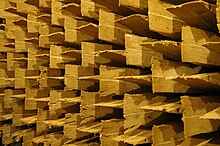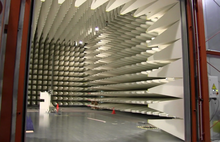Low reflection room
A ( anechoic ) anechoic room (generally speaking anechoic room ) is a special acoustic laboratory room, the boundary surfaces of which are designed in such a way that almost no sound is reflected from it. Other names are anechoic chamber or anechoic chamber .

Because of the special properties of the sound field resulting therefrom, such a room enables or simplifies various acoustic examinations and certain sound recordings.
Low reflection room delimitation surfaces

The minimization of the sound reflection on the walls and the ceiling is achieved by cladding with absorber material , mostly glass or mineral wool is used. In these materials, the energy of the incident sound is converted into thermal energy. The energy can only be withdrawn by friction with the moving air. This means that the speed of sound must be greater than zero. Depending on the frequency, this is maximum at a certain distance from the concrete wall of the room. At this point there must be porous material in order to optimally dampen the corresponding frequency. In order to achieve as complete a sound absorption as possible, the sound impedance must correspond to that of the air in the widest possible frequency range . This is done by building the lining from individual wedges of absorber material. Depending on the intended lowest absorbing frequency, such a lining with wedges can reach considerable depths (e.g. 1.50 m). In order to prevent sound reflections on the floor, the lower surface of the room must also be designed to be sound-absorbing. So that the room is still easily accessible, a lattice floor or a strong pre-tensioned wire mesh is installed in such a room. In order to minimize the effects of interfering noise from the area around the room, the walls are often additionally provided with sound insulation or the room is even built on its own foundation as a “house within a house” to decouple vibrations.
Sound field
Due to the lack of reflections on the walls, the ceiling and the floor, the sound field corresponds to that outdoors at a great height above the floor ( free field ). Therefore, these rooms are also referred to as free-field rooms or free-field laboratories . The law of distance applies and thus a fixed relationship between the sound power of a sound source and the effective value of the sound pressure at a certain location at a known distance. In addition, the sound pressure-time signal sent by a sound source remains unaffected by the room. These two properties of the sound field allow the room to be used for various acoustic examinations and sound recordings. In a semi-free field room, a room with anechoic walls and a reverberant , i.e. reflective floor, the sound field corresponds to the field outdoors at floor level.
application areas
One area of application for anechoic rooms is the determination of the sound power of devices, machines and vehicles. The sound power is determined from measurements of the sound pressure level on an envelope surface around the sound source.
In addition, such spaces are for calibration of measuring microphones used and other electro-acoustic transducers. Thereby u. a. the transfer function and the directional characteristics of such converters are determined. An anechoic room is also required to measure head-related transfer functions HRTF . By placing a number of loudspeakers in an anechoic room around a listening position, sound fields can be generated artificially. This means that experiments on sound perception are possible as well as making it audible, for example. B. of concert halls, called auralization .
Another area of application for such rooms is sound recordings for radio plays, features and film synchronization where the action takes place outside. A low-reflection studio is therefore part of the usual space in a radio play complex. In order to achieve the appropriate sound impressions, such rooms also have accessible areas with wooden floorboards, gravel or leaves. Low-reflection rooms for sound recordings are usually designed to be more visually appealing than the aforementioned rooms for acoustic measurements.

